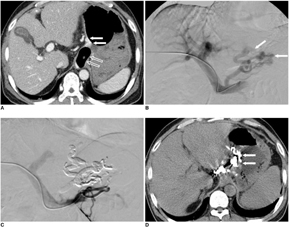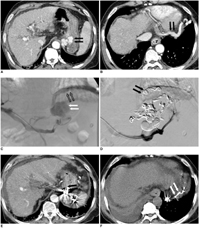Korean J Radiol.
2008 Dec;9(6):526-533. 10.3348/kjr.2008.9.6.526.
Percutaneous Transportal Sclerotherapy with N-Butyl-2-Cyanoacrylate for Gastric Varices: Technique and Clinical Efficacy
- Affiliations
-
- 1Department of Radiology, Research Institute of Clinical Medicine, Chonbuk National University Medical School and Hospital, Chonbuk, Korea. ymhan@chonbuk.ac.kr
- KMID: 1118874
- DOI: http://doi.org/10.3348/kjr.2008.9.6.526
Abstract
OBJECTIVE
This study was deigned to evaluate the technique and clinical efficacy of the use of percutaneous transportal sclerotherapy with N-butyl-2-cyanoacrylate (NBCA) for patients with gastric varices. MATERIALS AND METHODS: Seven patients were treated by transportal sclerotherapy with the use of NBCA. For transportal sclerotherapy, portal vein catheterization was performed with a 6-Fr sheath by the transhepatic approach. A 5-Fr catheter was introduced into the afferent gastric vein and a microcatheter was advanced through the 5-Fr catheter into the varices. NBCA was injected through the microcatheter in the varices by use of the continuous single-column injection technique. After the procedure, postcontrast computed tomography (CT) was performed on the next day and then every six months. Gastroendoscopy was performed at one week, three months, and then every six months after the procedure. RESULTS: The technical success rate of the procedure was 88%. In six patients, gastric varices were successfully obliterated with 1-8 mL (mean, 5.4 mL) of a NBCA-Lipiodol mixture injected via a microcatheter. No complications related to the procedure were encountered. As seen on the follow-up endoscopy and CT imaging performed after six months, the presence of gastric varcies was not seen in any of the patients after treatment with the NBCA-Lipiodol mixture and the use of microcoils. Recurrence of gastric varices was not observed during the follow-up period. Worsening of esophageal varices occurred in four patients after transportal sclerotherapy. The serum albumin level increased, the ammonia level decreased and the prothrombin time increased at six months after the procedure (p < 0.05). CONCLUSION: Percutaneous transportal sclerotherapy with NBCA is useful to obliterate gastric varices if it is not possible to perform balloon-occluded retrograde transvenous obliteration.
Keyword
MeSH Terms
-
Aged
Catheterization
Contrast Media/administration & dosage
Enbucrilate/*administration & dosage
Esophageal and Gastric Varices/radiography/*therapy
Female
Fluoroscopy
Humans
Iodized Oil/administration & dosage
Male
Middle Aged
Portal Vein
Sclerotherapy/*methods
Tissue Adhesives/*administration & dosage
Tomography, X-Ray Computed
Ultrasonography, Interventional
Figure
Reference
-
1. Sarin SK, Lahoti D, Saxena SP, Murthy NS, Makwana UK. Prevalence, classification and natural history of gastric varices: a long-term follow-up study in 568 portal hypertension patients. Hepatology. 1992. 16:1343–1349.2. de Franchis R, Primignani M. Natural history of portal hypertension in patients with cirrhosis. Clin Liver Dis. 2001. 5:645–663.3. Trudeau W, Prindiville T. Endoscopic injection sclerosis in bleeding gastric varices. Gastrointest Endosc. 1986. 32:264–268.4. Ramond MJ, Valla D, Mosnier JF, Degott C, Bernuau J, Rueff B, et al. Successful endoscopic obturation of gastric varices with butyl cyanoacrylate. Hepatology. 1989. 10:488–493.5. Oho K, Iwao T, Sumino M, Toyonaga A, Tanikawa K. Ethanolamine oleate versus butyl cyanoacrylate for bleeding gastric varices: a nonrandomized study. Endoscopy. 1995. 27:349–354.6. Ogawa K, Ishikawa S, Naritaka Y, Naritaka Y, Shimakawa T, Wagatsuma Y, et al. Clinical evaluation of endoscopic injection sclerotherapy using n-butyl-2-cyanoacrylate for gastric variceal bleeding. J Gastroenterol Hepatol. 1999. 14:245–250.7. Snady H. The role of sclerotherapy in the treatment of esophageal varices: personal experience and a review of randomized trials. Am J Gastroenterol. 1987. 82:813–822.8. Korula J, Chin K, Ko Y, Yamada S. Demonstration of two distinct subsets of gastric varices. Observations during a seven-year study of endoscopic sclerotherapy. Dig Dis Sci. 1991. 36:303–309.9. Naga M, Foda A. An unusual complication of histoacryl injection. Endoscopy. 1997. 29:140.10. See A, Florent C, Lamy P, Levy VG, Bouvry M. Cerebrovascular accidents after endoscopic obturation of esophageal varices with isobutyl-2-cyanoacrylate in 2 patients. Gastroenterol Clin Biol. 1986. 10:604–607.11. Benedetti G, Sablich R, Lacchin T, Masiero A. Endoscopic treatment of bleeding duodenal varices by bucrylate injection. Endoscopy. 1993. 25:432–433.12. Rossle M, Haag K, Ochs A, Sellinger M, Noldge G, Perarnau JM, et al. The transjugular intrahepatic portosystemic shunt-shunt procedure for variceal bleeding. N Engl J Med. 1994. 330:165–171.13. LaBerge JM, Somberg KA, Lake JR, Gordon RL, Kerlan RK Jr, Ascher NL, et al. Two-year outcome following transjugular intrahepatic portosystemic shunt for variceal bleeding: results in 90 patients. Gastroenterology. 1995. 108:1143–1151.14. Sanyal AJ, Freedman AM, Luketic VA, Purdum PP 3rd, Shiffman ML, DeMeo J, et al. The natural history of portal hypertension after transjugular intrahepatic portosystemic shunts. Gastroenterology. 1997. 112:889–898.15. Kanagawa H, Mima S, Kouyama H, Gotoh K, Uchida T, Okuda K. Treatment of gastric fundal varices by balloon-occluded retrograde transvenous obliteration. J Gastroenterol Hepatol. 1996. 11:51–58.16. Fukuda T, Hirota S, Sugimura K. Long-term results of balloon-occluded retrograde transvenous obliteration for the treatment of gastric varices and hepatic encephalopathy. J Vasc Interv Radiol. 2001. 12:327–336.17. Hirota S, Matsumoto S, Tomita M, Sako M, Kono M. Retrograde transvenous obliteration of gastric varices. Radiology. 1999. 211:349–356.18. Kitamoto M, Imamura M, Kamada K, Aikata H, Kawakami Y, Kurihara Y, et al. Balloon-occluded retrograde transvenous obliteration of gastric fundal varices with hemorrhage. AJR Am J Roentgenol. 2002. 178:1167–1174.19. Takahashi K, Yamada T, Hyodoh H, Yishikawa T, Katada R, Nagasawa K, et al. Selective balloon-occluded retrograde sclerosis of gastric varices using a coaxial microcatheter system. AJR Am J Roentgenol. 2001. 177:1091–1093.20. Koito K, Namieno T, Nagakawa T, Morita K. Balloon-occluded retrograde transvenous obliteration for gastric varices with gastrorenal or gastrocaval collaterals. AJR Am J Roentgenol. 1996. 167:1317–1320.21. Sonomura T, Sato M, Kishi K, Terada M, Shioyama Y, Kimura M, et al. Balloon-occluded retrograde transvenous obliteration for gastric varices: a feasibility study. Cardiovasc Intervent Radiol. 1998. 21:27–30.22. Ninoi T, Nakamura K, Kaminou T, Nishida N, Sakai Y, Kitayama T, et al. TIPS versus transcatheter sclerotherapy for gastric varices. AJR Am J Roentgenol. 2004. 183:369–376.23. Choi YH, Yoon CJ, Park JH, Chung JW, Kwon JW, Choi GM. Balloon-occluded retrograde transvenous obliteration for gastric variceal bleeding: its feasibility compared with transjugular intrahepatic portosystemic shunt. Korean J Radiol. 2003. 4:109–116.24. Kiyosue H, Matsumoto S, Yamada Y, Hori Y, Okino Y, Okahara M, et al. Transportal intravariceal sclerotherapy with N-butyl-2-cyanoacrylate for gastric varices. J Vasc Interv Radiol. 2004. 15:505–509.25. Cello JP, Ring EJ, Olcott EW, Koch J, Gordon R, Sandhu J, et al. Endoscopic sclerotherapy compared with percutaneous transjugular intrahepatic portosystemic shunt after initial sclerotherapy in patients with acute variceal hemorrhage. A randomized, controlled trial. Ann Intern Med. 1997. 126:858–886.26. Rossle M, Deibert P, Haag K, Ochs A, Olschewski M, Siegerstetter V, et al. Randomised trial of trnasjugular-intrahepatic-portosystemic shunt versus endoscopy plus propranolol for prevention of variceal rebleeding. Lancet. 1997. 349:1043–1049.27. Tripathi D, Therapondos G, Jackson E, Redhead DN, Hayes PC. The role of the tansjugular intrahepatic portosystemic stent shunt (TIPSS) in the management of bleeding gastric varices: clinical and haemodynamic correlations. Gut. 2002. 51:270–274.28. Chikamori F, Kuniyoshi N, Shibuya S, Takase Y. Correlation between endoscopic and angiographic findings in patients with esophageal and isolated gastric varices. Dig Surg. 2001. 18:176–181.29. Watanabe K, Kimura K, Matsutani S, Ohto M, Okuda K. Portal hemodynamics in patients with gastric varices: a study in 230 patients with esophageal and/or gastric varices using portal vein catheterization. Gastroenterology. 1988. 95:434–440.
- Full Text Links
- Actions
-
Cited
- CITED
-
- Close
- Share
- Similar articles
-
- Multiple Cerebral Infarction after Injection of N-Butyl-2-Cyanoacrylate for Gastric Variceal Bleeding
- Spinal, Cerebral and Cerebellar Embolism after Injection of N-Butyl-2-Cyanoacrylate in Esophageal Variceal Bleeding
- An adrenal gland abscess after N-butyl-2-cyanoacrylate (Histoacryl(R)) injection therapy for gastric varices bleeding
- Practical Approach to Endoscopic Management for Bleeding Gastric Varices
- Effect of Endoscopic Sclerotherapy Using N-butyl-2-cyanoacrylate in Patients with Gastric Variceal Bleeding



